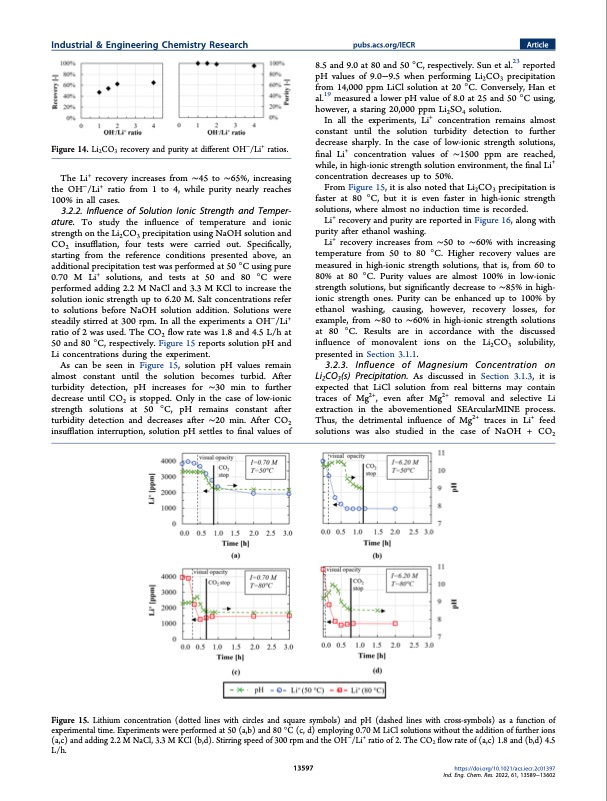
PDF Publication Title:
Text from PDF Page: 009
Industrial & Engineering Chemistry Research pubs.acs.org/IECR Article −+ Figure 14. Li2CO3 recovery and purity at different OH /Li ratios. The Li+ recovery increases from ∼45 to ∼65%, increasing the OH−/Li+ ratio from 1 to 4, while purity nearly reaches 100% in all cases. 3.2.2. Influence of Solution Ionic Strength and Temper- ature. To study the influence of temperature and ionic strength on the Li2CO3 precipitation using NaOH solution and CO2 insufflation, four tests were carried out. Specifically, starting from the reference conditions presented above, an additional precipitation test was performed at 50 °C using pure 0.70 M Li+ solutions, and tests at 50 and 80 °C were performed adding 2.2 M NaCl and 3.3 M KCl to increase the solution ionic strength up to 6.20 M. Salt concentrations refer to solutions before NaOH solution addition. Solutions were steadily stirred at 300 rpm. In all the experiments a OH−/Li+ ratio of 2 was used. The CO2 flow rate was 1.8 and 4.5 L/h at 50 and 80 °C, respectively. Figure 15 reports solution pH and Li concentrations during the experiment. As can be seen in Figure 15, solution pH values remain almost constant until the solution becomes turbid. After turbidity detection, pH increases for ∼30 min to further decrease until CO2 is stopped. Only in the case of low-ionic strength solutions at 50 °C, pH remains constant after turbidity detection and decreases after ∼20 min. After CO2 insufflation interruption, solution pH settles to final values of 8.5 and 9.0 at 80 and 50 °C, respectively. Sun et al.23 reported pH values of 9.0−9.5 when performing Li2CO3 precipitation from 14,000 ppm LiCl solution at 20 °C. Conversely, Han et al.19 measured a lower pH value of 8.0 at 25 and 50 °C using, however, a staring 20,000 ppm Li2SO4 solution. In all the experiments, Li+ concentration remains almost constant until the solution turbidity detection to further decrease sharply. In the case of low-ionic strength solutions, final Li+ concentration values of ∼1500 ppm are reached, while, in high-ionic strength solution environment, the final Li+ concentration decreases up to 50%. From Figure 15, it is also noted that Li2CO3 precipitation is faster at 80 °C, but it is even faster in high-ionic strength solutions, where almost no induction time is recorded. Li+ recovery and purity are reported in Figure 16, along with purity after ethanol washing. Li+ recovery increases from ∼50 to ∼60% with increasing temperature from 50 to 80 °C. Higher recovery values are measured in high-ionic strength solutions, that is, from 60 to 80% at 80 °C. Purity values are almost 100% in low-ionic strength solutions, but significantly decrease to ∼85% in high- ionic strength ones. Purity can be enhanced up to 100% by ethanol washing, causing, however, recovery losses, for example, from ∼80 to ∼60% in high-ionic strength solutions at 80 °C. Results are in accordance with the discussed influence of monovalent ions on the Li2CO3 solubility, presented in Section 3.1.1. 3.2.3. Influence of Magnesium Concentration on Li2CO3(s) Precipitation. As discussed in Section 3.1.3, it is expected that LiCl solution from real bitterns may contain traces of Mg2+, even after Mg2+ removal and selective Li extraction in the abovementioned SEArcularMINE process. Thus, the detrimental influence of Mg2+ traces in Li+ feed solutions was also studied in the case of NaOH + CO2 Figure 15. Lithium concentration (dotted lines with circles and square symbols) and pH (dashed lines with cross-symbols) as a function of experimental time. Experiments were performed at 50 (a,b) and 80 °C (c, d) employing 0.70 M LiCl solutions without the addition of further ions (a,c) and adding 2.2 M NaCl, 3.3 M KCl (b,d). Stirring speed of 300 rpm and the OH−/Li+ ratio of 2. The CO2 flow rate of (a,c) 1.8 and (b,d) 4.5 L/h. 13597 https://doi.org/10.1021/acs.iecr.2c01397 Ind. Eng. Chem. Res. 2022, 61, 13589−13602PDF Image | Recovery of Lithium Carbonate from Dilute Li Rich Brine

PDF Search Title:
Recovery of Lithium Carbonate from Dilute Li Rich BrineOriginal File Name Searched:
acs.iecr.2c01397.pdfDIY PDF Search: Google It | Yahoo | Bing
Product and Development Focus for Infinity Turbine
ORC Waste Heat Turbine and ORC System Build Plans: All turbine plans are $10,000 each. This allows you to build a system and then consider licensing for production after you have completed and tested a unit.Redox Flow Battery Technology: With the advent of the new USA tax credits for producing and selling batteries ($35/kW) we are focussing on a simple flow battery using shipping containers as the modular electrolyte storage units with tax credits up to $140,000 per system. Our main focus is on the salt battery. This battery can be used for both thermal and electrical storage applications. We call it the Cogeneration Battery or Cogen Battery. One project is converting salt (brine) based water conditioners to simultaneously produce power. In addition, there are many opportunities to extract Lithium from brine (salt lakes, groundwater, and producer water).Salt water or brine are huge sources for lithium. Most of the worlds lithium is acquired from a brine source. It's even in seawater in a low concentration. Brine is also a byproduct of huge powerplants, which can now use that as an electrolyte and a huge flow battery (which allows storage at the source).We welcome any business and equipment inquiries, as well as licensing our turbines for manufacturing.| CONTACT TEL: 608-238-6001 Email: greg@infinityturbine.com | RSS | AMP |